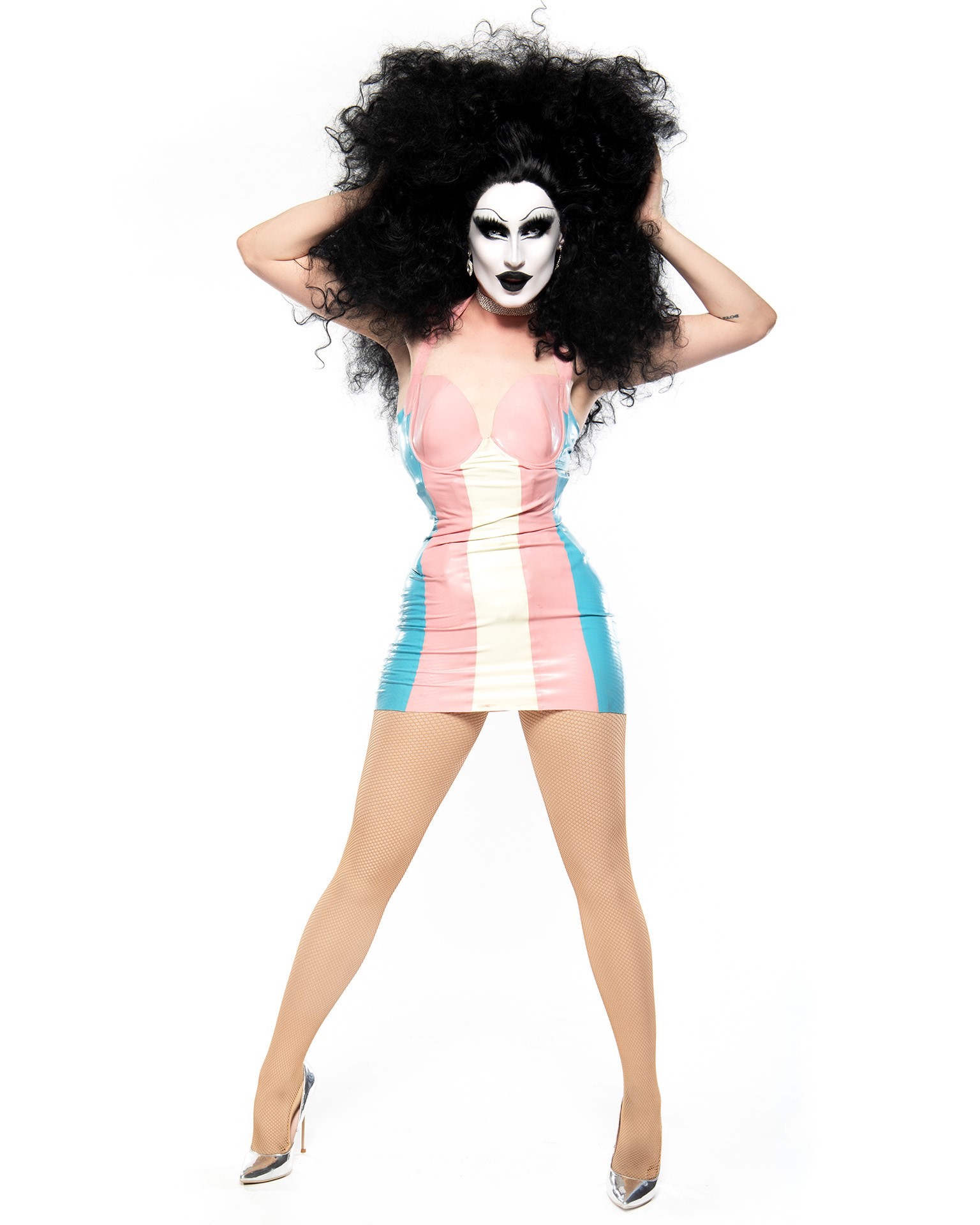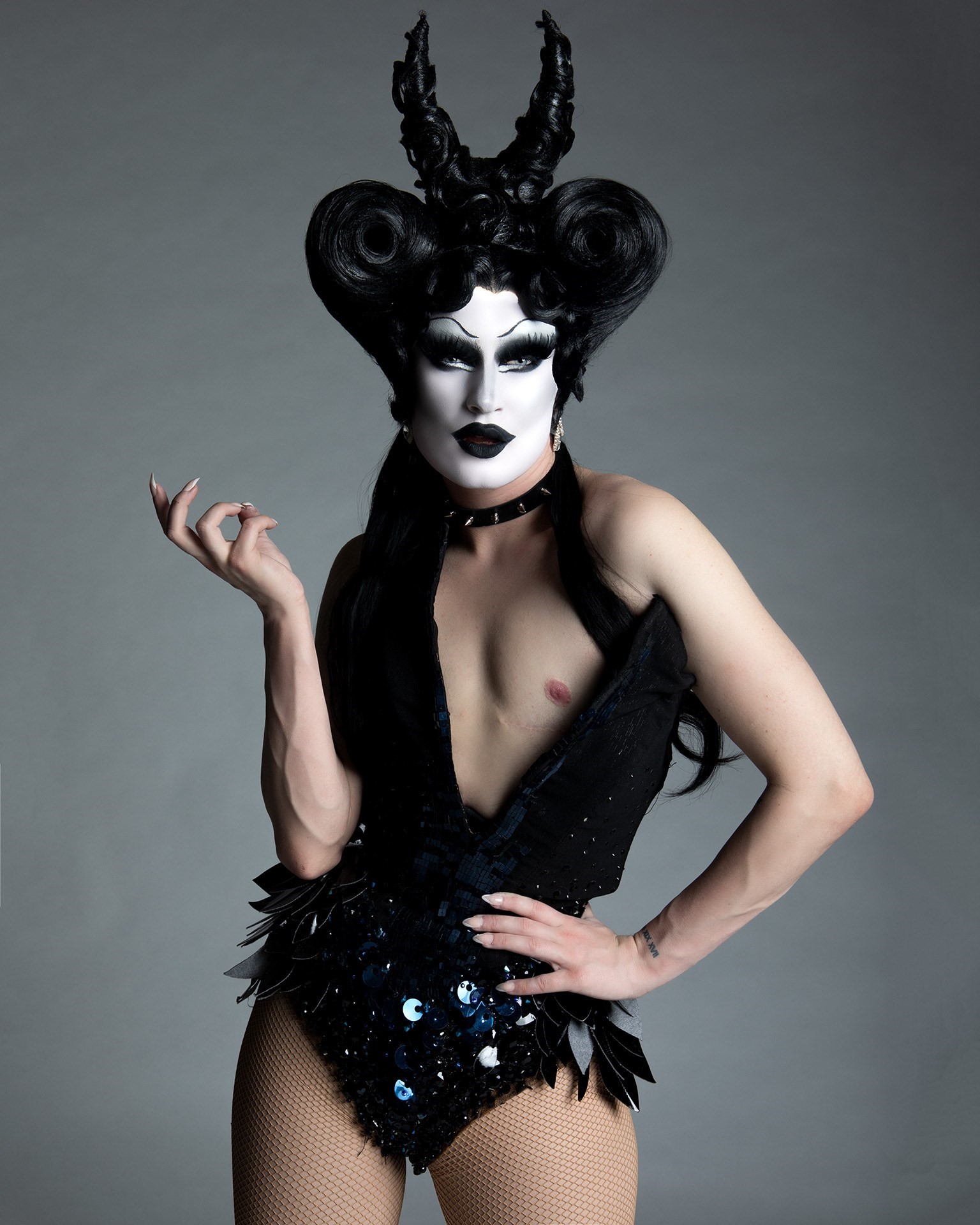Gottmik is partway through the make-up application process for a tour show starting hours from now. “I’ve been taking, like, all day to do my make-up now,” Mik confesses, over a slightly-uncrisp Zoom audio connection. “It’s kind of fun.” The luxurious ability to do make-up for the better part of an afternoon comes with the whirlwind pandemic year Mik’s had: absolutely killing it on this season of RuPaul’s Drag Race, making it to the final four in competition at the age of only 24, and touring all across the US now, starting out in San Francisco and making the long trek east.
It’s easy to talk to Gottmik, who is chatty, bubbly, and gracious. The sentences rush forth and run into each other, eager and much less precise than the art Mik is so successfully making. Her looks throughout this season of Drag Race were consistently razor-sharp, incorporating affinities for 80s punk, horror-film grotesquerie, and neo-Club Kid irreverence without ever sacrificing high-fashion polish. “I channel as much of this, like, punk rock, crashing-the-system, fighting-the-patriarchy energy I can,” Mik says of the aesthetic, which definitely has a harder edge to it, an almost anarchic feel. The centrepiece of the Gottmik stylistic world is the signature face, which – with its comic-graphic eyes, single-penstroke brows, heavy lips, and, usually, clown-white base – is rebellious in its own right.
“I wanted my scars out. I wanted to just be like: look at my trans body walking down the runway. I needed to have a naked moment” – Gottmik
During a “little black dress”-themed runway on Drag Race this season, in a moment of a different kind of rebellion, Gottmik came around the corner in the littlest black dress: doll-sized, A-line, adhered over her crotch. She wore small constellations of black rhinestones over each of her nipples, onyx eyeliner and lipstick, a good pump, and nothing else. “It was so in the box,” Mik breezes, when I ask about it, “that it became outside of the box.” But the little black dress look, more than most of Gottmik’s others this season, held significance beyond itself. As the first trans man to ever compete on Drag Race, Kade Gottlieb – Mik’s out-of-drag self, who uses “he/him” pronouns to Gottmik’s “she/her” – was also the first person to strut a transmasculine body down that famous stretch of soundstage, in full view of the world. “I wanted my scars out,” Mik recalls, referring to top surgery scars. “I wanted to just be like: look at my trans body walking down the runway. I needed to have a naked moment.”
Gottlieb grew up in Arizona, in a desert town where there wasn’t much in the way of queer community or art. He was the little kid always hunched over a sketchbook, copying Van Goghs and Picassos as early as the first grade. His parents eventually put him in art lessons, where he learned drawing and painting technique. By the time he was in (Catholic) high school, Gottlieb was stirring the pot, adding unauthorised adornments – “100 billion gold chains and my craziest shoes” – to the uniform. “I was the president of my school,” Mik recalls. “I would give speeches, and then just walk off the podium and grab my detention slip from the nun.”

In those early years, many of the relevant interests were already percolating: horror movies, the London punk scene, Keith Haring, high fashion. Gottlieb was accepted to the Fashion Institute of Design and Merchandising at age 18, and moved solo to Los Angeles (“I always knew I was an LA person,” Mik gushes). In fashion school, he gravitated towards Vivienne Westwood, John Galliano, Alexander McQueen – “anyone that was out there making statements,” in his summation. “The shock value of fashion, around that time, was just everything to me.”
While still at FIDM, he began doing make-up gigs via quirky LA happenstance. “I got hired to walk the red carpet for the Hunger Games premiere as a Capitol person, because I was just, like, dressed crazy,” Mik says, quickly enough that you could have missed the detail, “and RuPaul’s old make-up artist was there.” The make-up artist was intrigued and impressed by what Gottlieb had done with his face for the red carpet, and began introducing him to drag queens. Soon, Gottlieb was doing make-up for them – and later, once he decided to pursue make-up artistry as a career, for the likes of Paris Hilton and Heidi Klum.
“I loved expressing myself through this feminine art form, but I wanted to look more like an artistic alien thing, as opposed to a pretty girl” – Gottmik
At the time, Gottlieb hadn’t yet transitioned, and it was in fits and starts that he began putting make-up and drag on himself. He describes his drag and gender journeys as roads that crossed and coalesced: “I was going through so much, trying to figure out my life, not understanding it,” he recalls of himself at that time, “but being able to put it into Gottmik helped me figure it out. Testing the boundaries of what I’m comfortable with with my femininity helped me understand myself out of drag.”
Part of that careful navigation of performative femininity included, at first, steering completely clear of skin-toned face make-up. “I didn’t want to look too feminine,” Mik explains. “I loved expressing myself through this feminine art form, but I wanted to look more like an artistic alien thing, as opposed to a pretty girl.” So, along with the seedlings of the persona, the clown-white face was born.
Still, Gottmik is a femme creature. For a young Gottlieb, exposure to someone like him – transmasculine and interested in different degrees of feminine expression – might have had a big impact. Gottmik serves, for a lot of young people right now, as that allowance: she’s a figurehead for a specific kind of gender play that doesn’t, yet, crop up in many other visible places. “My DMs are full of people that are the exact same way,” Mik reports of the feedback, a lot of which has come from queer and trans kids. “Like, oh my god – we just needed to take up space and talk about it!”
As time has gone on, Mik’s stringent rules about feminine presentation in drag have relaxed. “Now that I’m comfortable with who I am out of drag,” Mik says, “I am super down to play with just looking like a really pretty drag queen.” Gottmik definitely does pretty, though the drag is rarely only pretty, or straightforwardly so: there’s a kind of freaky, androgynous specter that runs, like a current, underneath it, animating latex crash dummies and generally raising hell. Even when Gottmik does royal elegance, as she did for the Drag Race finale, she does it with an open ribcage.
“I want to do what I came here to do. Crash the system, fight the patriarchy. Open doors for the queer community from all angles” – Gottmik
Mik tells me the drag is “the sum of everything that I’ve worked for,” which, at 24, has already included around three career shifts, continuing gender discovery, an infusion of activist spirit, and changes to the aesthetic aimed at getting more in tune with the out-of-drag desires. Most likely, the drag will continue to adjust, get more specific; Mik is young, and drag, gender, and knowing oneself are all ongoing processes – in motion, subject to change forever. So far, the sum is a little bit punk rock, a little bit gothic bad dream, and a little bit high-fashion circus. Its boldness and tendency to boundary-shatter comes, of course, from Gottlieb’s person, but also from Gottmik’s worldview, which is centred on loud presence and making different kinds of trouble.
When I ask about what’s next, the voice in my computer answers with zeal, a cauldron frothing over. “I want to do what I came here to do,” Mik says. “Crash the system, fight the patriarchy. Open doors for the queer community from all angles.” Also, model. And MC. And maybe dip a toe into comedy. A lot is possible when the rules don’t apply.
